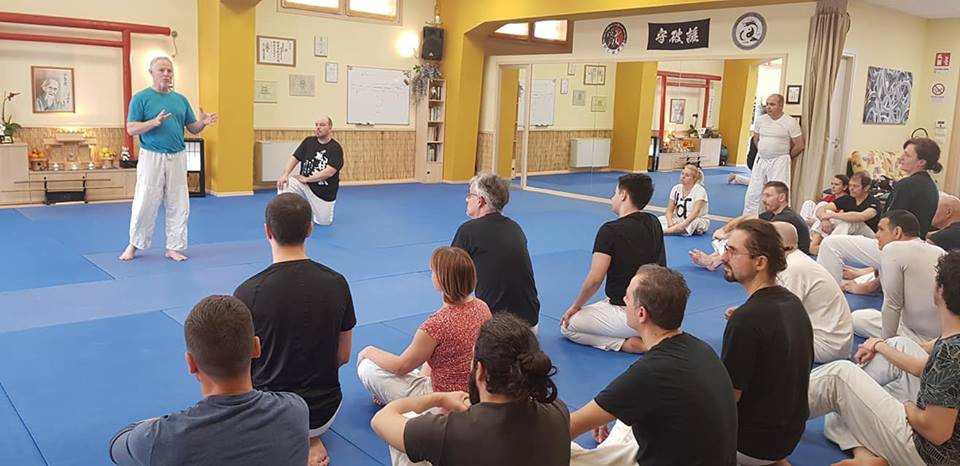When corporate strategy is poor, it often generates marketing campaigns containing reheated pay-offs. One of them -that one I dislike more- usually sounds: “BRAND_NAME, the innovation in the tradition” Or vice versa. No matter what the brand sells: items of furniture, clothes, ICT services or ice creams. Why this kind of marketing runs across the ages, it is a mystery. Better: there are excellent reasons why poor marketing still works and exists, but this would lead the post off topic.
The fact is that we got used, over years to a kind of communication which doesn’t match any longer with the underlying ideas and realities. We limit ourselves to the slogans, to the pay-offs, and the pervasiveness of social networks further restricts such limits, for such means usually do not facilitate the dialogue nor the willing to broadly explore a subject.
During the last weekend, the Hara Kai Dojo hosted in Turin Italy, the annual Evolutionary Aikido Seminar, an international event guided by Patrick Cassidy Sensei, who proposed to the participants of the Sunday’s class a new methodology he labeled “Aiki Combat Improv“.
Those who surf the Martial Arts’ Oceans, well know that that kind of sea is populated by thousands of names, federations, associations, ranks, brands, belts, publications, events, circles, habits, languages, acronyms…
It often happens that the way an Art is taught and communicated generates fragmentation, separations and neverending as useless attempts to state that a group is right and another one is wrong, despite the original spirit of the founder of the discipline.
On the other hand, humankind history teaches us that the capability to evolve and to adapt grants to the cultures to be alive across centuries, so that we embody the very same principles of our ancestors although we live very different experiences in very different environments.
Patrick Cassidy and his Evolutionary Aikido Community are committed in the search of a kind of “living language”, originating from a 35-years experience on the tatami, that may communicate and keep alive those principles that are underlying the practice of Aikido and actually the practice of every other martial art: the capability to connect with the partner and include the partner in a flow. And obviously, the consequent attributes of such principles, feeling, connecting, blending with the partner, stepping in toward the attacker, accepting to explore outside the borders of our comfort zone, letting that the events generate the movement…
Sometimes we have to undress ourselves to discover who we are. We have to unmask ourselves in order to understand where we are heading to.
The robotic repetition of techniques is a severe risk. It surely may lead to a beautiful formal and powerful exhibition but it could be empty and it could generate hollow individuals who increase the disorder in a fragmented, apparently hetero-directed world.
The opposite temptation, that is a practice with no rules, leads to the very same risky outcomes.
For this reason, we appreciated the effort in searching a new way to teach old and timeless principles. Because Samurai’s Japan doesn’t exist anymore. Because everyone has the right to understand what he does. Because everyone has the right to feel and discover principles that may be useful for daily life.
So, apart from the visible aspects of this accurate methodology (no ranks, no hierarchy, no uniforms, no techniques, just a clear mandate to get partner’s center line, to include with no resistance when one is pushed, pulled or grabbed, and a strong injection of close, light contact that strongly reminds Wing Chun, Tai Chi and the “chi sao” idea of sticking hands…Marco Rubatto provides a complete report of the methodology on his blog), this “Aiki Combat Improv” turned out to be a golden nugget for our practice.
Free from the almost known sequences of techniques and allowed to express our intentions through fluid movements we had the chance to assess our developmental stage of awareness. In other terms, the “improvisation” deriving from a light contact combat, put in the spotlight of the principles our Aikido experience end naturally gave us the direction and the tools to evolve, improving.
Summing up, “Aiki Combat Improv” is a good label with a lot of good stuff behind: you can feel the taste of the huge experience of a teacher who lived for years in Japan practicing every day the “old school”, passing through its pains and its tresaures and reshaping it, thanks to an ongoing research, in a form that preserves as well the tradition without disdaining the innovation.
Strongly recommended!
Photo Credits: Sandra Bridel

